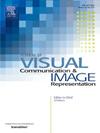RBMark: DT CWT域的鲁棒盲视频水印
IF 2.6
4区 计算机科学
Q2 COMPUTER SCIENCE, INFORMATION SYSTEMS
Journal of Visual Communication and Image Representation
Pub Date : 2025-03-22
DOI:10.1016/j.jvcir.2025.104438
引用次数: 0
摘要
基于变换域的视频水印嵌入算法对媒体处理方法具有鲁棒性,但数据嵌入容量有限。近年来,基于学习的水印算法因其在图像特征提取和数据嵌入方面的优异性能而受到越来越多的关注。然而,它们对各种视频处理方法的鲁棒性并不一致。为了有效地平衡嵌入容量和鲁棒性,本文提出了一种基于双树复小波变换(DT CWT)的RBMark视频水印方法。首先,在嵌入阶段将水印码流转换为关键图像。其次,分别从视频帧和关键图像中提取DT CWT域系数,并将关键图像系数嵌入到视频帧系数中;在提取阶段,提取关键图像系数进行逆DT CWT,重构水印比特流。与现有的水印算法相比,RBMark具有更高的鲁棒性和嵌入容量。我们使用多个代表性视频数据集来评估其性能,并与先验变换域和基于学习的水印算法进行比较。实验结果表明,与基于变换域和基于学习的方法相比,RBMark的误码率分别提高了98%和99%。此外,RBMark可以在每个1080p分辨率的视频帧中最多嵌入2040位(即9.84×10 - 4位每像素)。源代码可在此URL中获得。本文章由计算机程序翻译,如有差异,请以英文原文为准。
RBMark: Robust and blind video watermark in DT CWT domain
Video watermark embedding algorithms based on the transform domain are robust against media processing methods but are limited in data embedding capacity. Learning-based watermarking algorithms have recently become increasingly popular because of their good performance in image feature extraction and data embedding. However, they are not consistently robust against various video processing methods. To effectively trade off the embedding capacity and robustness, this paper proposes RBMark, a novel video watermarking method based on Dual-Tree Complex Wavelet Transform (DT CWT). First, the watermark bit-stream is transformed into a key image in the embedding phase. Second, we extract the DT CWT domain coefficients from both the video frame and the key image and embed the key image coefficients into the video frame coefficients. During the extraction phase, the key image coefficients are extracted to perform inverse DT CWT and reconstruct the watermark bit-stream. Compared with prior watermarking algorithms, RBMark achieves higher robustness and embedding capacity. We evaluated its performance using multiple representative video datasets to compare with prior transform domain and learning-based watermarking algorithms. Experimental results demonstrate that RBMark achieves up to 98% and 99% improvement in Bit Error Rate over the transform domain and learning-based methods, respectively. Furthermore, RBMark can embed at most 2040 bits in each 1080p-resolution video frame (i.e., bits per pixel). The source code is available in this URL.
求助全文
通过发布文献求助,成功后即可免费获取论文全文。
去求助
来源期刊

Journal of Visual Communication and Image Representation
工程技术-计算机:软件工程
CiteScore
5.40
自引率
11.50%
发文量
188
审稿时长
9.9 months
期刊介绍:
The Journal of Visual Communication and Image Representation publishes papers on state-of-the-art visual communication and image representation, with emphasis on novel technologies and theoretical work in this multidisciplinary area of pure and applied research. The field of visual communication and image representation is considered in its broadest sense and covers both digital and analog aspects as well as processing and communication in biological visual systems.
 求助内容:
求助内容: 应助结果提醒方式:
应助结果提醒方式:


